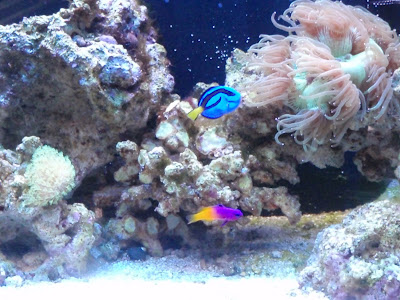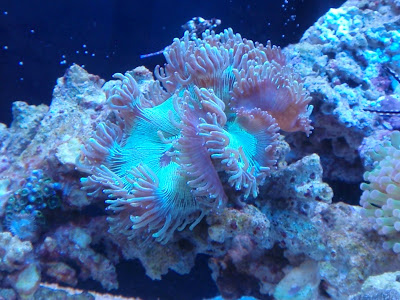I have yet to do a post on common saltwater fish illnesses (ick, marine velvet, lateral line erosion, etc.). Obviously, in lieu of recent events, this post is called for (can you guess what I will be posting in the next few days?). But for today, let's focus on why I'm interested in saltwater fish illnesses in the first place.
I introduced Chantal to the tank on Saturday. She had just come to my favorite LFS from Hawaii on Thursday. The guy at the LFS was hesitant to sell her to me, not sure about their health since they had just come in. I decided to risk it; I had missed out last time! When I came back to see which one was the healthiest, they were all sold! The LFG (local fish guy) selected the healthiest one and carefully netted him into a bag with tankwater for me to take home. Upon introducing her the tank, she seemed very happy, eating, swimming, playing with the other tankmates. I was very encouraged.
On Thursday, I noticed several lumps on the right side of her body, near the dorsal fin and her belly. They looked like hard, warty, cauliflower-like lumps. The coloring was pale to reddish. Other than that, Chantal's behavior was unchanged. Eating, swimming around happily. Nonetheless, I knew those bumps were not supposed to be there. I had to do something. Quick! What was going on with my prize fish?

Chantal with mysterious lumps on right side of body (particularly near dorsal fin).
After some research on-line and talking with 3 different fish "experts", I'm still not entirely sure what it is. I've ruled out some of the more common Blue Tang illnesses like ich and marine velvet. (Btw, I found out that tangs are more susceptible to these diseases because they have skin, not scales. Kind of cool, huh? I guess that's what makes them both very sensitive to water parameters as well as beautiful. If you haven't guessed, these are my favorite type of fish.) Both of those have a white powdery appearance (more like salt sprinkling for ich and a smooth fluffy coat for marine velvet). My vote is for lymphocystis.
What is lymphocystis?
Juvenile emperor angel with classical lymphocystis on fins.
" Lymphosystis is a viral growth that can appear on the fins and skin of aquarium fish. Lymph can be distinguished from other tumors by its distinctive appearance. Close inspection of the Lymphocystis nodule reveals white to gray cauliflower or raspberry-like growths that usually begin at the tips of the fish's fins and may eventually spread to other areas of the fish's body. Usually, the cuase of Lymph is from unusual stress or shipping. Lymph that appears on new additions to the tank is most likely caused from the stress of capture and transport.
Symptoms: White to gray, cauliflower or raspberry-like groths on the fins or body of the fish.

Yellow Tang with Lymphocystis (a fish who doesn't normally get this disease).

Clownfish with Lymphocystis (also a fish who doesn't normally get this disease).

Chantal with mysterious lumps. What do you think?

Close up of Chantal's warty lumps.
Treatment:
"Since lymph is not very contagious or fatal, the best treatment is to leave the fish in the main tank and let the disease run its course. If you have an ultraviolet light, keep it on to stop the spread of the virus. If the Lymph tumor covers most of the mouth, causing eating problems for the fish, the growth should be removed. If you want to perform the surgery, net the fish and place it on a clean, wet towel. With a scalpel or new razor blade, carefully trim the portion of Lymph that is obstructing the mouth. Be careful not to cut into the actual skin, if at all possible. Disinfect the area by dabbing it with a cotton swab dipped in a broad spectrum antiseptic such as betadine. Let the drug penetrate for ten seconds then place the fish directly back in the main tank. Do not keep the fish out of the water for more than one minute."
Let's compare notes.
First, Chantal is an easily stressed fish. In addition, she's been through A LOT over a very short amount of time. From Hawaii to 2 different tanks in less than a week. That's quite a bit of travelling, shipping, and introduction to new tanks in a short amount of time! Not to mention being removed from the wild (I'm kicking myself for not ordering a captive-bred blue tang on-line). Particularly for a type of fish (blue tang) that's very sensitive to stress. Okay, so we have a reason for how she became immunocompromised and susceptible to disease.
Let's look at her symptoms. Cauliflower like bumps on her body that are pale gray to raspberry colored. Um. Wow! Did they look at Chantal before giving that description? Check.
The disease is usually asymptomatic and non-lethal. Hmmm. Chantal is behaving and eating normally (although she does itch her bumps on the rock; normal for tangs. I would too if I had all those nasty lumps on me!). So far, so good.
Strikes against a lymphocystis diagnosis? Well, tangs don't normally get this virus (angels and butterflies do). And the lumps are usually localized to the edges of the fins, not on the body itself.
Thankfully, if it is lymphocystis, the virus is asymptomatic, rarely infects other fish, and usually goes away on its own. That's very good news. On the flip side, there is no known cure for lympocystis (kind of like there is no cure for the common cold). All in all, I'm hoping this is what is plaguing Chantal. Poor Chantal has the flu. (Greg says she has the fish form of poison ivy).
What have I done to help Chantal? First, I made sure no fish were bullying her. Check. If anything, she calls the shots in the tank. It's a very happy family. Second, I did a 20% water change. Lots of scrubbing away excess grime and algae. New filter sock and new activated carbon. I tested all the water parameters. Temp 80, specific gravity 1.024, pH 8.5, nitrates 0, phosphates 0, alkalinity 8, calcium 400. Looks good. In addition, it's stable. That's what it was 1 month ago. I have 2 cleaner shrimp in there that are supposed to help clean parasites off fish (unfortunately, they seem to squirm away as if cleaning were ticklish). I also added a bluestreak cleaner wrasse (more on this in a later post). She immediately tried to clean the fish in the tank. Again, most of them swam away. I think they thought she was getting fresh with them! Poor Scooter (scooter blenny) protested quite vividly, "Hey! I'm not that kind of fish!" The last thing I'm doing is feeding Chantal (and the other fish) frequent feedings (3x/day) of a varied diet (oyster eggs, prawn eggs, mysis, other frozen meats, veggies, seaweed, etc.). Anyway, I'm hoping these measures will help Chantal.
In general, I have read that for sick fish, if she is eating normally and behaving normally, the best course of action is to leave it alone. Most likely, the fish's immune system will fight it off on her own. This is basically what I'm doing. Just monitoring. Of course, if your fish is displaying more harmful symptoms (not eating, lethargic, swimming on its side, breathing heavily, or infecting other fish), more drastic action needs to be taken. I'll go over these details in a later post but briefly, treatments include: removing the sick fish and placing her in a hospital tank, freshwater dip, and copper treatment (as well as lots of others on the market; NOTE: Be careful! Lots of treatments will kill your inverts and coral, especially copper!). Take into consideration that every treatment will add stress to your fish, potentially weakening her immune system. You have to weight the risks and benefits and decide what's best for your ailing fish.

Chantal itching on a rock.

Another view of Chantal itching.
Video of Chantal itching her bumps.
Most importantly, what do you think? Does Chantal have lymphocystis? Something else? How can I help her? Suggestions?
Links about Lymphocystis:








.jpg)












































